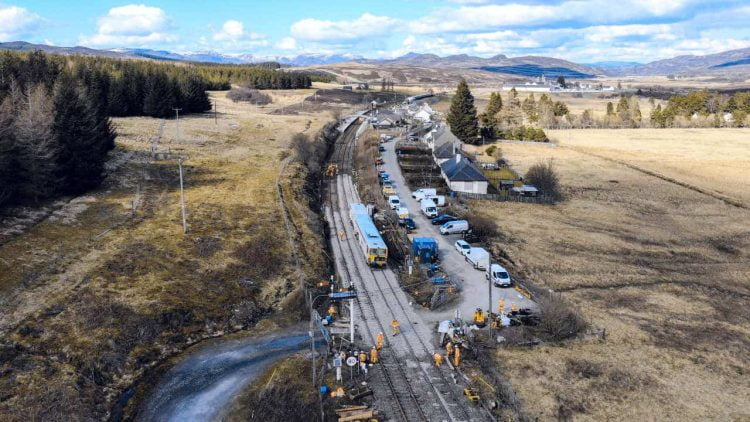The Rail Accident Investigation Branch (RAIB) has released its report into a signalling failure and train derailment at Dalwhinnie in the Scottish Highlands.
At around 03.01 on 10th April, a ScotRail HST was operating an empty coaching stock movement and was travelling at 33 mph when it derailed after it was wrongly diverted from the main line onto a crossover south of Dalwhinnie station in Badenoch and Strathspey.

No one was injured, but the consequences could have been much worse if the train had been travelling much faster and carrying passengers, or if it had met a train travelling on the line to which the crossover led.
The train was diverted onto the wrong track because, even though the signaller had set the points for the route along the main line, those at the facing end of the crossover had remained set towards the crossover, while the points at the trailing end had moved to their correct position.
The point machine at the trailing end of the crossover had been replaced in July 2021, but when it was replaced a mistake was made in wiring the signalling system. That allowed the signaller to clear the protecting signal, and allowed the train to approach the crossover. The front of the train was directed over the crossover, but it then trailed through and forced apart the points at the trailing end.
Only then did the signalling system detect that the points were incorrectly set. The signalling system then automatically re-sent the command for both point ends to move to the position that the signaller had set earlier. This second command caused the points at the facing end to move whilst the train was on them, causing the rear of the train to derail as it passed over them.
The wiring error was because there were two unwanted conductors, a wire strap and a metal link, in the replacement trailing end point machine. Those conductors were only used when this type of point machine was installed at single-ended point locations.
The responsibility for installing and testing the replacement point machine lay with the local signalling maintenance team, but they did not realise that the crossover at Dalwhinnie was unique to the area. Also, because the two point machines shared the same design of point position detection circuit, the spare conductors should have been be removed from the point machine when it was installed.
When the renewal work was planned the requirement to alter the internal wiring was not identified, and testing and commissioning of the point machine followed Network Rail’s standard procedure for installing a like- for- like replacement during signalling maintenance work.
The wiring discrepancy was not identified during the checks and wire counting that were required to be carried out before and after the point machine was installed. The last point at which the wiring error could have been identified before the points were handed back into service was an out-of-correspondence test. However, the specified testing work was interrupted by the need to wait for the signaller to arrive at the signal box. As a result, this and other outstanding testing work was overlooked, the tester in charge believing that it had already been completed.
The investigation found that Network Rail’s signalling maintenance standards were unclear in the working arrangements of the appointed tester and of those carrying out this type of like-for-like installation work. It identified the lack of clarity as a probable underlying factor.
RAIB has submitted five recommendations to Network Rail:
- define the tasks and responsibilities of signalling maintenance teams when carrying out pre-planned like-for-like equipment replacement work;
- define how the independence of testing and installation roles is best assured;
- provide appropriate information and warnings for replaceable items of signalling equipment;
ensure the effectiveness of pre-installation checks; - make suitable arrangements for recording the progress and findings of signal maintenance testing.
Andrew Hall, Chief Inspector of Rail Accidents said: “Some of the causes of the accident at Dalwhinnie bear an alarming similarity to those found in the multi-fatal accident at Clapham Junction in 1988, and the more recent collision at Waterloo in 2017 which caused huge disruption on routes into London. These accidents share a common theme, that an undetected wiring error resulted in the failure of the signalling system. At Dalwhinnie, this meant that the signalling system did not detect that some points were in an unsafe position, resulting in the derailment of a train. Thankfully no one was injured. However, the train could have been carrying passengers and travelling at a much higher speed, and the outcome very different.
“Wiring within a signalling system is safety critical and needs to be carefully checked and tested when engineering work is carried out. It is essential that long-established processes and assurance principles, introduced and developed as a result of earlier accidents, are followed. When essential technical information is not readily available, and testing is not completed or carried out in a truly independent manner, the consequences can be very serious.
“Those who don’t remember the past are condemned to repeat it, has been said in many ways by many people. When it comes to fully understanding the importance of hard-learned lessons around the wiring of railway signalling, the accident at Dalwhinnie needs to act as another salutary reminder to the industry.”






Responses